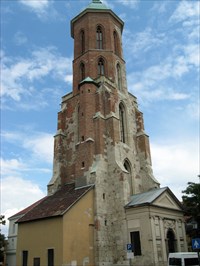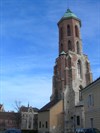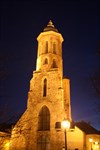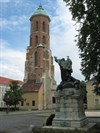
This Mary Magdalene (Mária Magdolna) church has a very sad story, but tells a lot about Hungarian history. The church was built in the 13th century, around 1250. After the Turkish invasion it was the only church left for Christians, but in the end of the 16th century it was also transformed into a mosque. Later on, the church was restored and king Frantz I was crowned here. In the Second World War, the church suffered serious damage and during the communist dictatorship, it was demolished except for its gothic tower and a couple of other parts. It has still not been rebuilt. Today it stands as a memento for the unforgivable cultural destruction of the communist era.
Photo: By anna schwelung - Indafotó, CC BY 2.5 hu, https://commons.wikimedia.org/w/index.php?curid=16828721
This track is a walking the route with an audio guide to Budapest. A full-day trip is a great way to get to know the city and its history. The excursion begins at the Opera building, then through the park goes to the Parliament building. From the parliament building, which is highly recommended to visit, the embankment route passes to the memorial to the victims of the Holocaust. Then we cross the Danube along one of the most recognizable bridges in Europe and the most famous bridge in Budapest - the Széchenyi Bridge. In the part of the city that used to be called Buda, we will climb the hill of the royal castle and find ourselves in the most beautiful places. There are the Fisherman's Bastion, the ancient streets, and towers and at the end of the exploration of this part of the city, we will descend into an underground labyrinth with rock paintings. At the end of the beautiful day, we will visit the museum of the Jewish mystic illusionist Houdini, the most famous funicular in Europe and the zero kilometer of the Hungarian Republic.
Welcome to Waymarking.com!We hope you've been able to find what you are looking for. We would also like to encourage you to take some time to browse some of the other aspects of our site. We recommend viewing our featured waymarks, or perhaps the newest waymarks. You can also create a free membershipto track your progress online and share your locations with others.Click here to view the complete waymark directory |
Posted by: N 47° 30.223 E 019° 01.728 34T E 351555 N 5263025 Quick Description: Remaining tower of the church from 13 century, destroyed in the WW-II Location: Budapest, Hungary Date Posted: 8/3/2011 6:55:10 AM Waymark Code: WMC775 Published By: Views: 23 Long Description: [EN] This Mary Magdalene (Mária Magdolna) church has a very sad story, but tells a lot about Hungarian history. The church was built in the 13th century, around 1250. After the Turkish invasion it was the only church left for Christians, but in the end of the 16th century it was also transformed into a mosque. Later on, the church was restored and king Frantz I was crowned here. In the Second World War, the church suffered serious damage and during the communist dictatorship, it was demolished except for its gothic tower and a couple of other parts. It has still not been rebuilt. Today it stands as a memento for the unforgivable cultural destruction of the communist era. [HU] A Mária Magdolna-templom szomorú sorsa egyben a magyar történelemrol is sokat mesél. A XIII. században épült, 1250 körül. A török megszállás idején csak a templomot hagyták meg a keresztényeknek, de a XVI. században azt is mecsetté alakították át. Késobb templomként renoválták, és itt koronázták meg I. Ferenc királyt. A világháborúk komoly károkat okoztak a templom szerkezetében, és a kommunista éra alatt a gótikus torony és néhány kisebb rész kivételével teljesen lerombolták. Ma már csak a romjai láthatóak, a kommunista idok megbocsáthatatlan kulturális pusztításának mementójaként.
Visit Instructions: When visiting the location, please try to take a picture with your GPSr if you are alone, or with members of your party in the shot. Also, please describe your visit/adventures so others will know what to expect when they get there. Please describe what makes the steeple unique or interesting. |








 .GPX File
.GPX File
